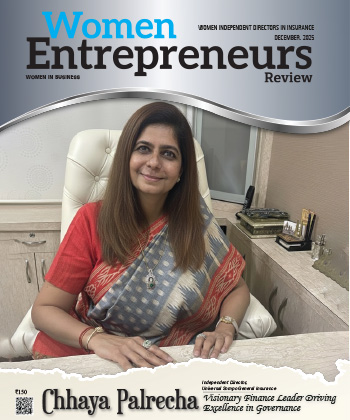
Women's Leadership Turning Tech Disruption into Enduring Value
By: Anshu Sarin, CEO, 91Springboard
Anshu Sarin is a dynamic leader of travel and hospitality, with extensive experience across hospitality and aviation. Known for driving turnarounds, digital transformation and customer -centered innovation, she combines strategic vision with practical execution, consistently offering revenue growth, operational excellence and long -term stakeholder value.
In an exclusive interaction with Women Entrepreneurs Review magazine, Anshu Sarin reflects on her journey leading digital transformation in various industries. From building inclusive culture to customer -centered innovation, she shares her insights on how women leaders can shape technology -oriented changes with empathy, resilience and measurable impact.
You've led digital transformations at Lemon Tree and now 91Springboard. How can women leaders shape tech-driven change while keeping empathy and inclusion at the core?
Digital transformation, at its best, reimagines how we engage with customers, streamline operations, and add value. It’s not about using flashy tools; it’s about solving real problems better.
Empathy plays a big role here. At 91Springboard, for example, we introduced tech that makes access seamless, bookings intuitive, and data more usable, but only after walking the floor, listening to the teams, and watching how members actually work.
As for inclusion, it’s not a campaign.
It’s about consistently building spaces where people regardless of gender can thrive and contribute. Women leaders are often wired to tune into those nuances. It’s strength but ultimately, it’s your outcomes that speak.
At Keys Hotels, you introduced segment-based brand architecture. How can women CEOs in legacy industries use customer insights to reframe traditional models digitally?
At Keys, we used real customer behaviour data like booking patterns, price sensitivity, service expectations to build three distinct sub-brands. It helped us speak clearly to different segments, rather than diluting the experience and having a one-size-fits-all product that tries to serve everyone the same way. This gave us clear pricing power and propelled our Net Promoter Scores skyward. We achieved higher rates, improved occupancy, and two new revenue channels in a mature market. Every new digital touchpoint, from online booking algorithms to guest feedback loops, was tracked for direct revenue and satisfaction lift.
This principle works across industries: listen to the customer, then design backwards. The digital layer gives you sharper insights if you know how to use them.
CEOs don’t need to “digitalise” for the sake of it. They need to ask: what’s not working? What are customers telling me, even if not in words? That’s where the reframing starts.
From Kingfisher loyalty programs to scaling revenue at Berggruen, what digital-first strategies helped build customer retention and how can others replicate them?
At Kingfisher Airlines, we took loyalty from a mere marketing activity to a powerful profit centre. Loyalty isn’t about discounts or gimmicks. It’s about earning the right to a long-term relationship. My roots are in value engineering. At Kingfisher and later in hospitality, we used digital tools to identify behaviour patterns about what customers value, when they drop off, and what brings them back.
At 91Springboard, that translates into intuitive platforms, seamless onboarding, and vibrant community engagement.
More importantly, we leverage data to anticipate churn, personalize experiences, and stay ahead of the curve, while validating every operational improvement by its financial multiplier and cultural dividends.
The replication isn’t in the tool, it’s in the mindset. Be curious, watch patterns, act fast and make sure your digital interventions create value, not noise. Our investments in automation and data-driven lead management pushed conversion rates and occupancy percentages to all-time highs, putting us ahead of both pandemic and market cycles.
During turnaround phases, you’ve balanced strategy and ground execution. How can women navigate disruption without losing operational grip?
You can’t lead from slides; you have to stay close to the floor. At Keys and Berggruen, we were in turnaround mode, and that meant balancing daily fires with long-term fixes.
The lesson: prioritise ruthlessly, delegate clearly and never lose sight of the user experience whether it’s a hotel guest, a startup founder, or an internal team.
Tech-driven disruption often looks glossy on paper. But it only works when operational realities are accounted for. Women, especially those juggling multiple roles often develop strong situational awareness, which can be used as an asset.
You’ve built collaborative cultures. How do you ensure digital upskilling includes and uplifts women at all levels?
Upskilling has to be continuous and relevant. It’s not just about new tools, it’s about mindset. We ensure people have access to what they need: knowledge, feedback, and the space to experiment.
We have also supported programs like ‘Level-Up’ with Google for Startups, a platform built to equip entrepreneurs, especially women, with digital skills and mentoring in the past.
It’s about access and equity, not handholding.
If you build clean systems and clear expectations, people grow and they do it on merit.
What advice would you give aspiring women leaders who face traditional mindsets or limited leadership access in tech transformation?
This is the legacy I’m building, one strategic digital leap, and one measurable impact at a time. To women facing outdated mindsets, I say this often: ditch perfection, trust your instincts, and stop apologizing for ambition. You don’t need to fit in a mold. You just need to deliver.
Resistance is real but so is capability.
If you stay grounded in results, build strong support systems, and lead with courage, things shift.
Sometimes slowly, but they do shift.
Your job isn’t to be liked. It’s to create value, build teams that thrive, and lead from the front and when you do that consistently, doors open even the ones you weren’t invited to knock on. In the end, digital transformation isn’t just about tools; it’s about turning every change into compounded value.
On the wider canvas, industry benchmarks confirm what my experience has shown: companies executing on digital strategy see up to 30% lower operational costs, 10–15% faster revenue cycles, and twofold increases in digital customer engagement.
Most Viewed
- 1 Women's Health Startup HerMD Closing Doors Amid Industry Challenges
- 2 5 Famous Women in Indian Armed Forces
- 3 Saudi Women No longer Require Male Permission for Clothing Choices, says Prince MbS
- 4 Kolkata Medtech Startup Innovodigm Raises Rs 5.5 Crore Seed Funding Led by IAN Group
- 5 Yamunanagar's Kashish Kalra Honoured after Securing 111th Rank in UPSC Civil Services Exam
- 6 Madurai Appoints Its First Woman Corporation Head
- 7 IAS Vijayalakshmi Bidari Appointed as the new Nagpur Divisional Commissioner
- 8 American Entrepreneur Lucy Guo Overtakes T Swift to become Youngest Female Billionaire
- 9 ICC Women's World Cup 2025 Trophy Showcased at Indore's Holkar Stadium
- 10 Aparna Saxena's Beauty Venture AntiNorm Launches in India
- 11 Vidya Nataraj Co-Founded BlueStone Jewellery & Lifestyle files IPO
- 12 5 Women Freedom Fighters of India
- 13 Dr. G Krishnapriya appointed as CEO for Trichy
- 14 M3M & Sirona Partner to Introduce Menstrual Hygiene Vending Machines in 15 Locations
- 15 Punjab Govt launches SHE Cohort 3.0 Supporting Tech-led Women Startups
- 16 Indian origin Lawyer, Sweena Pannu appointed as the US New Superior Court Judge
- 17 The Aurora Tech Award recognizes 4 Indian Women-led Startups
- 18 Kerala's Republic Day parade featured an all-female tableau
- 19 Manisha Kabbur Becomes Karnataka's First Woman International Karate Coach
- 20 Director K. S. Ravikumar's Daughter Maalica Ravikumar Launches Life Coaching Company 'Evergrowth Academy' for Women
- 21 Leezu's Raises Pre-Seed Funding to Accelerate Growth in Sexual Wellness Industry
- 22 Sattu: Super-easy summer drink for PCOS gut healing
- 23 Swathi Nelabhatla creates Sitha App, India's First Women-Exclusive Gig Platform
- 24 7 Timeless Female Kathak Dancers & their Iconic Legacies
- 25 Meet 7 Iconic Women Architects of Modern India & their Most Impactful Work
- 26 This Woman-led Insuretech Startup is Helping Bridge the Education Financing Gap in India
- 27 Women Leaders Share Lessons Learnt from India Women's WC Win
- 28 5 Enterprising Women Founders Powering Singapore's Tech & Innovation Landscape
- 29 4 Women. 4 Stories. One Vision for Smarter, Stronger Healthcare
- 30 Global Gender Gap Narrows to 68.8%, But Full Equality 123 Years Away: WEF Report 2025
- 31 Changemakers: 7 Women Entrepreneurs Taking the Make in India Movement Forward
- 32 Meet Lucy Guo, The Youngest Self-Made Female Billionaire Disrupting Tech
- 33 How Women are Driving India's Festive Online Shopping Surge






